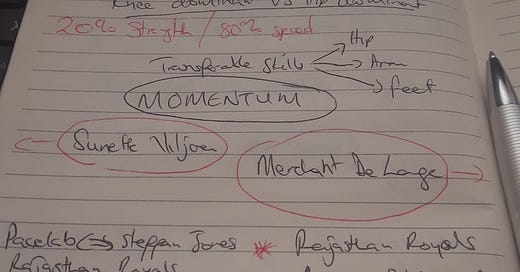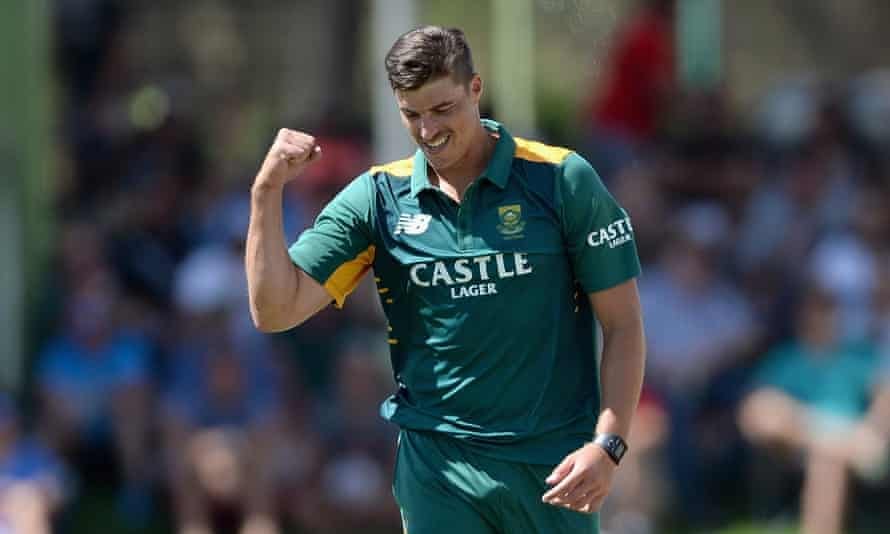Notes on the heavy ball, javelin and pace bowling
The question of how one can bowl a heavy ball led me into an interesting discovery of the interconnectedness of bowling and javelin.
I have found something new to obsess over. The heavy ball. I am intrigued by the mechanics of how someone can deliver a ball that is faster than it looks or anticipated. I am also curious to learn if there are strong connections between heavy ball bowlers (and other bowlers in general) and javelin throwers.
You see, I watched a good number of Olympic gold medalist Thomas Röhler's videos, and the action looks similar to that of a bowler. Not only that, but hips also act as an accelerator. According to knowledgeable people in the field, the hip drive/block is the holy grail of javelin throwing. This is because it creates so much of the power that goes into the throw.
This is interesting to me because when I had a chat with Piet Botha, former Warriors and Eastern Province head coach. He told me that the hip also plays a huge role in the mechanics of bowling a heavy ball.
According to Botha, "To gain power, to explode into an action and to maximize your strength – or in fact do just about anything that requires an increase in velocity – your hips provide the crucial clue. This is because the bulk of your power is likely to go where both your hip points."
The other interesting similarity that I noticed was at the point of release. How far a javelin goes is dependent on the thrower's point of release. This is also true for bowlers. Heavy ball bowlers delay their arm. As Botha explains, "When you delay letting go of the ball, it allows your muscles to stretch in sequence ahead of the actual ball release. This means the very last thing to come out of your delivery action is the ball."
Of great importance to bowling a heavy ball is the creation of long levers, which in turn generate chest drive which then makes arm delay easier and natural. And as long as you have a good position over the front leg, then "you get the sensation that you can bang the ball into the pitch hence a heavy ball."
All of the things that Piet Botha discussed with me from hip drive to the creation of long levers seem consistent with things that javelin throwers focus on. Now, I am not suggesting that a javelin thrower will make a good bowler or the other way around, but it's just too tempting to not notice the similarities. Hell, there are hip-dominant and knee-dominant javelin throwers in the same way that there are in fast bowling. For example, Pakistani bowler Mohammad Amir and javelin star Johannes Venter are both hip dominant and have similar biomechanics. On the other hand, Brett Lee was a knee-dominant bowler and has similar biomechanics as Thomas Röhler.
But, it is not just the similarities in some aspects of the technique that has me wondering and asking questions as to whether one might find it easier to move from one discipline to the other with little difficulty. With the fundamentals in place, surely, it will come down to individual adaptability, what Steffan Jones calls fluctuators, the soft skills (consider the fundamentals as the hard skills). As he writes, “fluctuators help us adapt to the environment but are specific to individual bowlers. It’s their own method of organizing and adapting to the environment (self-organizing).” These are as important to success to success as the fundamentals.
I mean, if the scientists from the Australia Institute of Sport could convert Michelle Steele (a gymnast) Melissa Hoar (a surfer) and Emma Sheers (a water skier) into Olympic skeleton athletes a mere 13 weeks after they had first tried it, what could stop a javelin thrower or bowler from making the switch if some of the fundamentals are related? In fact, there is the case of the mysterious Atul Sharma.
Atul Sharma was at one time considered the next big thing in pace bowling. He was trained by both cricket and javelin coaches. However, his career was short-lived as he suffered a serious injury just before his debut. Some writers consider him to be the fastest bowler India has never had. He is rumoured to have been able to generate speeds of up to 160km/h.
South Africa has had a handful of athletes who have gone from one discipline to the other. Olympic javelin silver medalist Sunette Viljoen used to be an allrounder, while pacer Merchant de Lange was a javelin thrower. In fact, there is speculation that it is his javelin-throwing background that helps him to consistently generate speeds from 145 to 150 km/h despite having a short run-up. Javelin throwers have a much smaller run-up, they take very few steps before completing their throw.
Former cricketer Steffan Jones of Pacelab, who also works as Rajasthan Royals' fast bowlers’ development coach, notes that there are four similar rotational nodes in both javelin throwing and fast bowling. These rotational nodes form the basics, the fundamentals of both practices.
In fact, world-renowned coach and author of a number of books that include Fast Bowler’s Bible, Ian Pont definitely sees the link. Pont has worked with phenoms such as Darren Gough and Dale Steyn, so his word should also carry a lot of weight. When he speaks, people tend to sit up and listen.
Speaking of the link between javelin throwers and cricket, Pont said, "If there was a better way to throw, javelin throwers would have found it. But isn’t there a difference? You bowl with a straight arm and deliver the ball downwards while a javelin is sent 80 to 90 meters in the air. Yes, but the principles are the same… we always knew about hip drive and arm pull as being important, plus keeping the legs driving through to target. Javelin helped cement some things in my mind as a coach."
Looseners or bad habits
Speaking of bowlers and bowling, I am not a fan of bowlers bowling looseners, especially in T20 and ODIs where the margins are ever so small. I dislike them so much that I have lost count of many times I want to change channels each time I have heard a commentator(s) remark, "That was a loosener," after a bowler bowls a delivery written “hit me” all over it. It's almost as if it is acceptable for bowlers to dish out pies because it is their first ball. And if it is not a pie, most bowl a wide.
For many of them, it's as if the first delivery of a spell has no purpose. This mindset, this habit, is one that I do not understand, and like poor fielding, it is an indicator of a team's culture and values. Teams or players with a winning mindset are less likely to be flippant about even the smallest detail of their performance out on the field because they understand that it is the small margins that can turn the tide and change the course of a match.
I discussed this issue with one of the best bowling coaches out there, Eric Simons, and he believes that it is something that can and will often result in bad habits that can cost the team victory.


If you read this article this far, I guess you can afford to read one or two extra lines. Thank you to everyone who has shown their appreciation for my work and this newsletter. I am entirely freelance but have no intention of putting content behind a paywall. However, for me to be able to continue producing more content, I depend on your patronage. So, please do support my work on Patreon.
Please encourage anyone you think may be interested in my work to subscribe.





